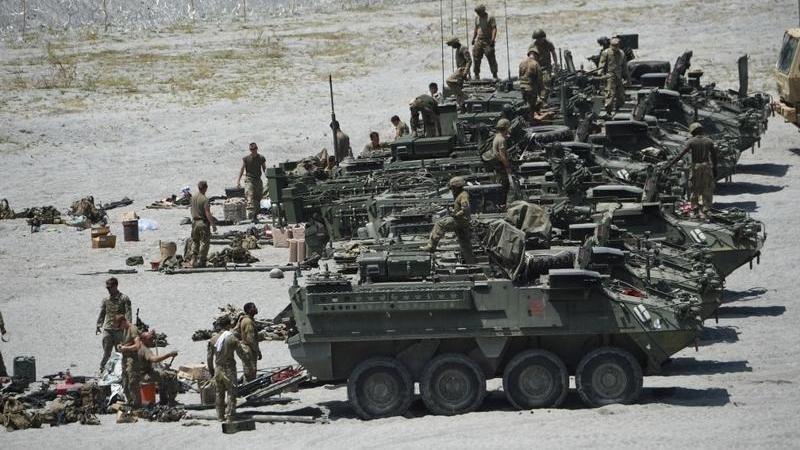 In this April 10, 2019 photo, US army personnel stand on top of their Interim armored carrier strykers as they prepare to leave after participating in the live fire exercises, as part of the annual US-Philippines joint military exercise at Crow Valley, in Capas town, Tarlac province, north of Manila. (PHOTO / AFP)
In this April 10, 2019 photo, US army personnel stand on top of their Interim armored carrier strykers as they prepare to leave after participating in the live fire exercises, as part of the annual US-Philippines joint military exercise at Crow Valley, in Capas town, Tarlac province, north of Manila. (PHOTO / AFP)
The Philippines needs to pursue a “multi-aligned” foreign policy, be vigilant and prioritize its national security interests to avoid being used in a proxy war, experts said. The warning came on the back of an enhanced military alliance between the Southeast Asian country and the United States under the Enhanced Defense Cooperation Agreement (EDCA).
Philippine President Ferdinand Marcos Jr said on March 22 that Filipino and American officials have identified four locations where the US can build additional military facilities announced in February.
Former Philippine national security adviser Clarita Carlos said the US “took advantage” of the Philippines’ dispute with China over the South China Sea in securing the additional EDCA sites
Former Philippine national security adviser Clarita Carlos said the US “took advantage” of the Philippines’ dispute with China over the South China Sea in securing the additional EDCA sites. Carlos said that the US is using the Philippines as part of its geopolitical strategy to prevent China’s rise as a superpower.
Carlos added that instead of siding with either China or the US, the Philippines should prioritize its national interest and pursue “multi-alignment”. She said there is a need to create a multipolar world, which hosts many centers of power and is not dominated by one superpower.
Anna Rosario Malindog-Uy, vice-president of external affairs for the Manila-based Asian Century Philippines Strategic Studies think tank, said the expansion of EDCA sites will not only militarize the Philippines but also the wider Asia-Pacific region.
ALSO READ: New military bases with US to be 'scattered' around Philippines
“EDCA expansion could propel an arms race in the region,” Malindog-Uy said, adding there is a “huge possibility” that the US would use EDCA sites as “launch pads in its planned war against China in the Taiwan Strait”. Malindog-Uy cited the “geopolitical and geostrategic rivalry” between China and the US in the Asia-Pacific and the “propensity of the US to wage a military conflict, aggression, and war” against China over its Taiwan.
Former Philippine undersecretary for foreign affairs Ernesto Abella said any “additional pressure” caused by the expansion of US military access will affect the geopolitical balance not only in the Philippines but also in the region. However, the Philippine government needs to manage the situation owing to the country’s proximity to the South China Sea and Taiwan of China, he added.
The Philippines and the US signed the EDCA in 2014, allowing the US military to rotate troops and operate facilities in the Philippines. In 2016, the Philippines and US identified five EDCA sites: the Antonio Bautista Air Base in the southwestern province of Palawan; the Mactan-Benito Ebuen Air Base in the central province of Cebu; the Lumbia Air Base in the southern province of Misamis Oriental; and Basa Air Base in Pampanga and Fort Magsaysay in Nueva Ecija, which are both located in the country’s north.
In February, following US Defense Secretary Lloyd Austin’s state visit to Manila, the two sides announced that the US military will have access to four additional sites.
ALSO READ: Philippines grants US greater access to bases
Wang Wenbin, spokesperson for China’s Ministry of Foreign Affairs, said in a March 21 press briefing that it is China’s consistent belief that defense and security cooperation between countries needs to be conducive to regional peace and stability, and not targeted at or harmful to the interests of any third party.
“The US side, out of selfish interests, remains trapped in a zero-sum mentality and keeps increasing military deployment in the Asia-Pacific. This would escalate tensions and endanger peace and stability in the region. Regional countries need to remain vigilant and avoid being coerced or used by the US,” Wang said.
Marcos is expected to announce the exact location of the four new facilities soon but he said in a March 22 press briefing that some of the additional EDCA sites will be in Palawan and the northern Philippines. There have been reports that one of the new EDCA sites will be located in the northeastern province of Cagayan.
Cagayan Governor Manuel Mamba said he opposes the plan to make the province an EDCA site as having foreign forces stationed there is “inimical” with the interests of local residents and the province, according to a report in The Manila Times newspaper.
READ MORE: Philippines: Expanded US access to bases 'not for aggression'
Senator Imee Marcos also questioned why EDCA sites would be located in the northern Philippines. Marcos, who heads the Senate Committee on Foreign Relations, said in a February hearing that local officials in northern Philippines were never consulted about the new EDCA sites.
Abella, the former foreign affairs undersecretary, said the Philippines needs to remain independent and neutral. He said while it is “valid” for the Philippines to seek US’ help in improving its armed forces, Philippine government officials also need to publicly acknowledge that the country will continue to abide with its one-China policy.
He said it is important that the Philippines has a clear foreign policy position: “We can’t allow other nations to define us. We need to define ourselves.”


